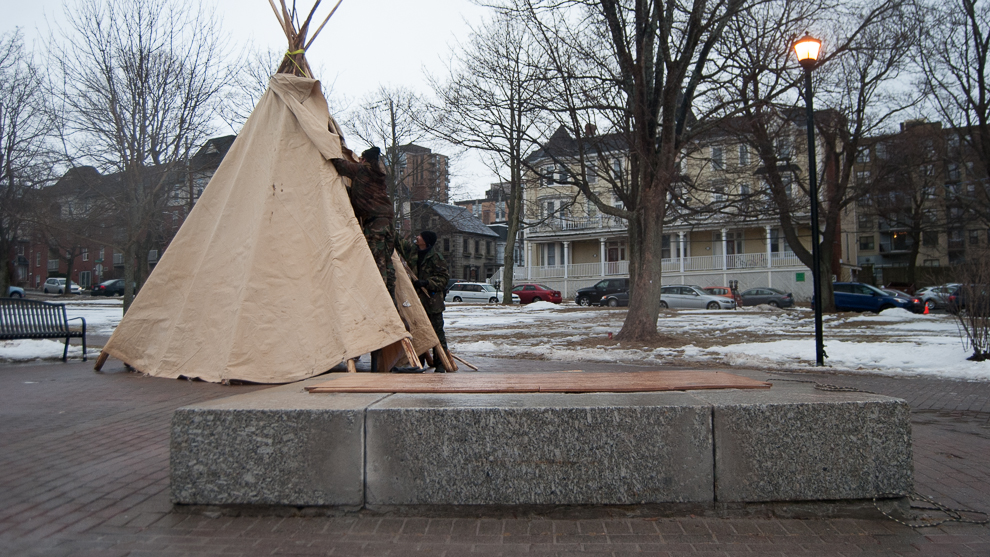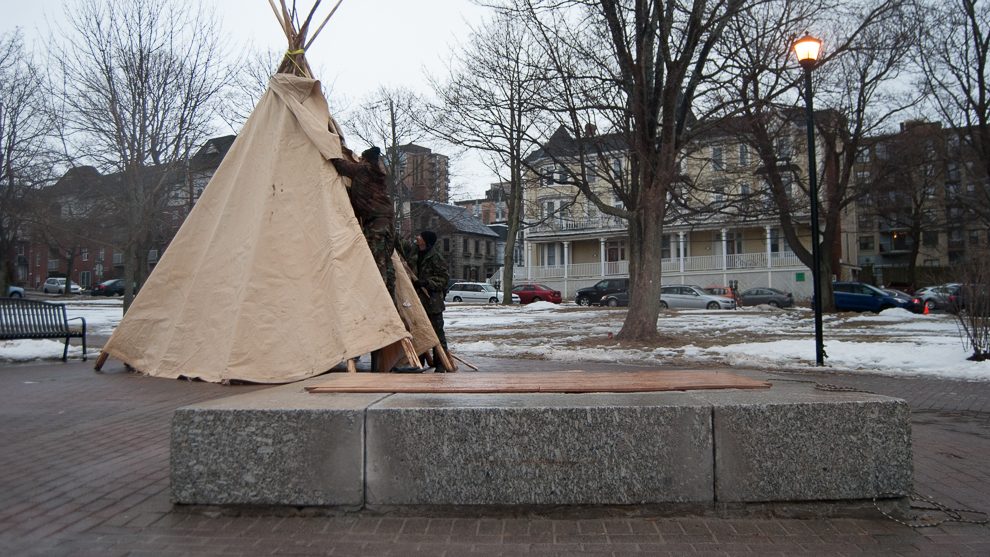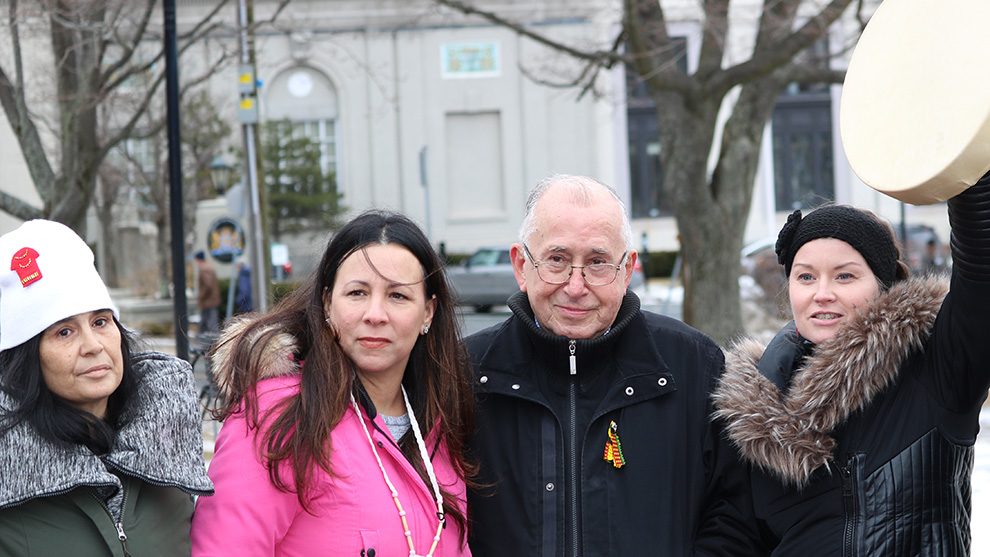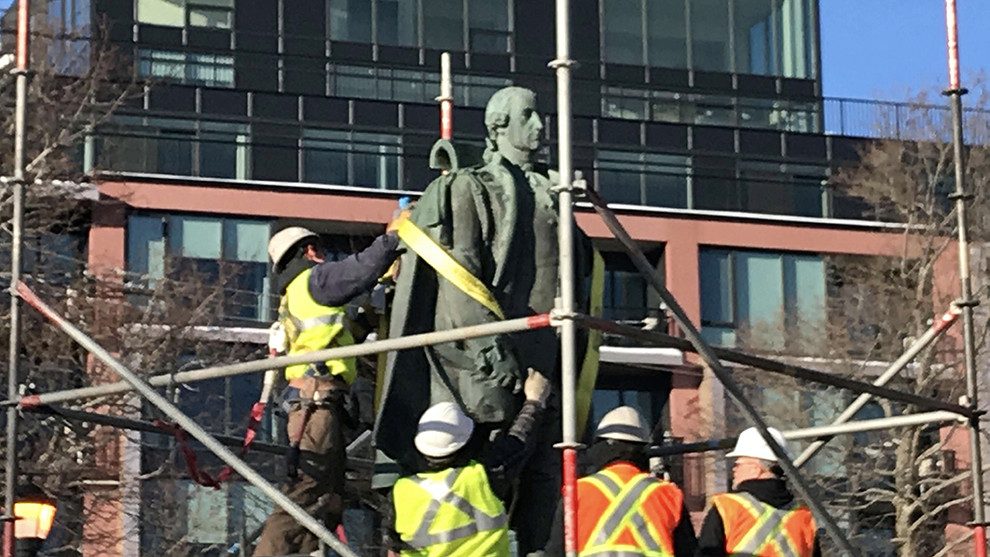Cornwallis
Taking down Cornwallis: historians weigh in on removal of statue
Using the Witt test as the criteria to assess the Cornwallis statue


caption
After Sunday’s rally in Cornwallis park to celebrate the statue’s removal, three Mi’kmaq men assembled a tipi to protest Alton Gas.The statue of Edward Cornwallis stood in a park named after him since 1931. Last week the statue was removed, to the joy of some and disappointment of others.
Daniel Paul, Mi’kmaq activist, historian and author of We Were Not the Savages, attended the Sunday celebration of the statue’s removal. While being thanked by other Mi’kmaq activists, Paul stood on the statue’s former pedestal.

caption
Daniel Paul stands with other Mi’kmaq members to celebrate the removal of the Cornwallis statue.For Paul, the glaring conflict between Cornwallis’s actions and the current values of Indigenous and non-Indigenous people in Canada was reason enough to remove the statue.
“It’s very contrary to Mi’kmaq values to have a statue of a man that advocated what today would be termed genocide,” says Paul. Related stories
Cornwallis’s infamy is largely based on a 1749 proclamation he issued which asked for scalps of Mi’kmaq people in exchange for money.
However, others disagree that monuments should be renamed or removed based on current values alone.
The Witt test
Peter Shawn Taylor, editor-at-large at Maclean’s, recommended, in a 2017 op-ed, that groups in Canada use the Witt test to decide whether a monument deserves to be renamed. The test, he argued, would bring a degree of order to debates that are overly emotional and political.
The test was created by John Witt, a professor of history at Yale. Answers to the questions should be weighed against each other when deciding whether to rename a monument.
In terms specific to Edward Cornwallis, the conditions are:
- Is the principal legacy of Cornwallis fundamentally at odds with our current values?
- Was the relevant principal legacy significantly contested in the time and place in which Cornwallis lived?
- Was the Cornwallis statue erected for reasons that are fundamentally at odds with our current values?
- Does Cornwallis play a substantial role in forming community in Halifax?
The test is supposed to centre the debate on historical facts rather than political argument, but there will still be disagreements over how to interpret the facts.
The Signal asked two historians to apply the Witt test to Cornwallis.
Cornwallis’s principal legacy
Is the principal legacy of Cornwallis fundamentally at odds with our current values?
John Boileau is the author of a dozen books on history. He has also written hundreds of opinion pieces for Halifax newspapers and has helped write articles, including one on Cornwallis, for the Halifax Military Heritage Preservation Society.
Boileau says that Cornwallis’s principal legacy is that he founded Halifax in 1749.
“No matter what he did elsewhere and here, he certainly deserves to be recognized as the founder of this city,” he says.
However, the founding of Halifax isn’t seen in the same light by others. John Reid is a professor of history at Saint Mary’s University and is the author of The Three Lives of Edward Cornwallis.
For Reid, Cornwallis’s primary legacy is a “serious effort of settler colonialism” — a legacy which does not accord with our current set of values.
Merely a man of his time?
Was the relevant principal legacy significantly contested in the time and place in which Cornwallis lived?
Boileau and Reid both relate this second question to scalping, which is an intrinsic part of what they each claim as Cornwallis’s principal legacy.
Boileau says Cornwallis’s was “a violent, turbulent time.” In North America in the 1600s and 1700s, “it was regular practice” among British, French, Acadians and Mi’kmaq to take scalps.
“No one comes out blameless here,” says Boileau. To him this means that in 1749, scalping was too common to be “significantly contested,” as Witt’s test requires.
Reid agrees that Cornwallis’s scalping bounty proclamations were “by no means unprecedented.” However, there is evidence that Cornwallis wasn’t simply a man obeying orders from above. Reid says Cornwallis had instructions from Britain to maintain friendly relationships with the Indigenous inhabitants. He did not abide by these instructions, which means that he may have been more brutal than others of his time.
Reid also warns against conflating the scalping done by the British with that done by the Mi’kmaq.
“It’s important to remember who was the invader and who was invaded. When people get invaded, they revolt,” he says.
The statue: Celebration of heritage or imperial icon?
Was the Cornwallis statue erected for reasons that are fundamentally at odds with our current values?
In 1931, Canadian National Railways provided most of the money to erect the statue, which cost $20,000 at the time. The railway thought it would help welcome tourists to the city and, as Boileau says, British pride was high during the interwar period. To Boileau, the statue was created to honour Canada’s British heritage — a reason which is not fundamentally at odds with Canadian values.
Reid doesn’t see this heritage as value neutral.
“How many people do you see today who think it’s a wonderful thing to glorify British colonialism?” he asks.
To this, Boileau would point to the many marks of British heritage in Canadian institutions, including the Royal Canadian Mounted Police, Governor General and the names of military ships. He argues these examples show that marks from colonial Britain aren’t always harmful.
Who cares?
Does Cornwallis play a substantial role in forming community in Halifax?
To both Boileau and Reid, this is the least important point in the test. The Cornwallis statue is only a statue, so it’s hard to see how it plays a substantial role in community-building.
In debates about other names, like those attached to Ryerson University or the Town of Amherst, it’s easier to see how the larger community would be affected by renaming.
However, Boileau argues that the figure of Cornwallis and history in general play a significant role in Halifax’s identity, so removing the statue chips away at both of these.

caption
The statue was removed from its pedestal on Jan. 31.‘White men’s conditions’
While Boileau and Reid disagree with each other within the confines of the test, Daniel Paul disagrees with the test itself. He calls the Witt test “white men’s conditions.”
Paul says it fails to take into account the Mi’kmaq perspective at any point in the process, and the test uses a British perspective when evaluating Cornwallis during his day. When evaluating the statue’s erection, it’s from a 1930s Canadian perspective. And when the test accounts for today’s values, it doesn’t employ specifically Mi’kmaq ones.
Paul’s personal test is simpler: Cornwallis scalped people and shouldn’t be honoured.
“None of (the colonial figures) should be,” he says.
He thinks that as North Americans continue to learn more about Indigenous history, monuments to colonial figures will continue to be renamed.
Already in Halifax, a school formerly called Cornwallis Junior High was renamed to Halifax Central Junior High School. The Cornwallis Street Baptist Church has also pledged to change its name.
“Across Canada and the United States there’s a whole progressive movement to get rid of colonial heroes of the past who committed atrocities,” he says.
The Cornwallis statue is now in storage at an undisclosed location. Over the next few months, Halifax regional council will decide its fate.


A
Anthony
D
Daniel Paul
D
Dan